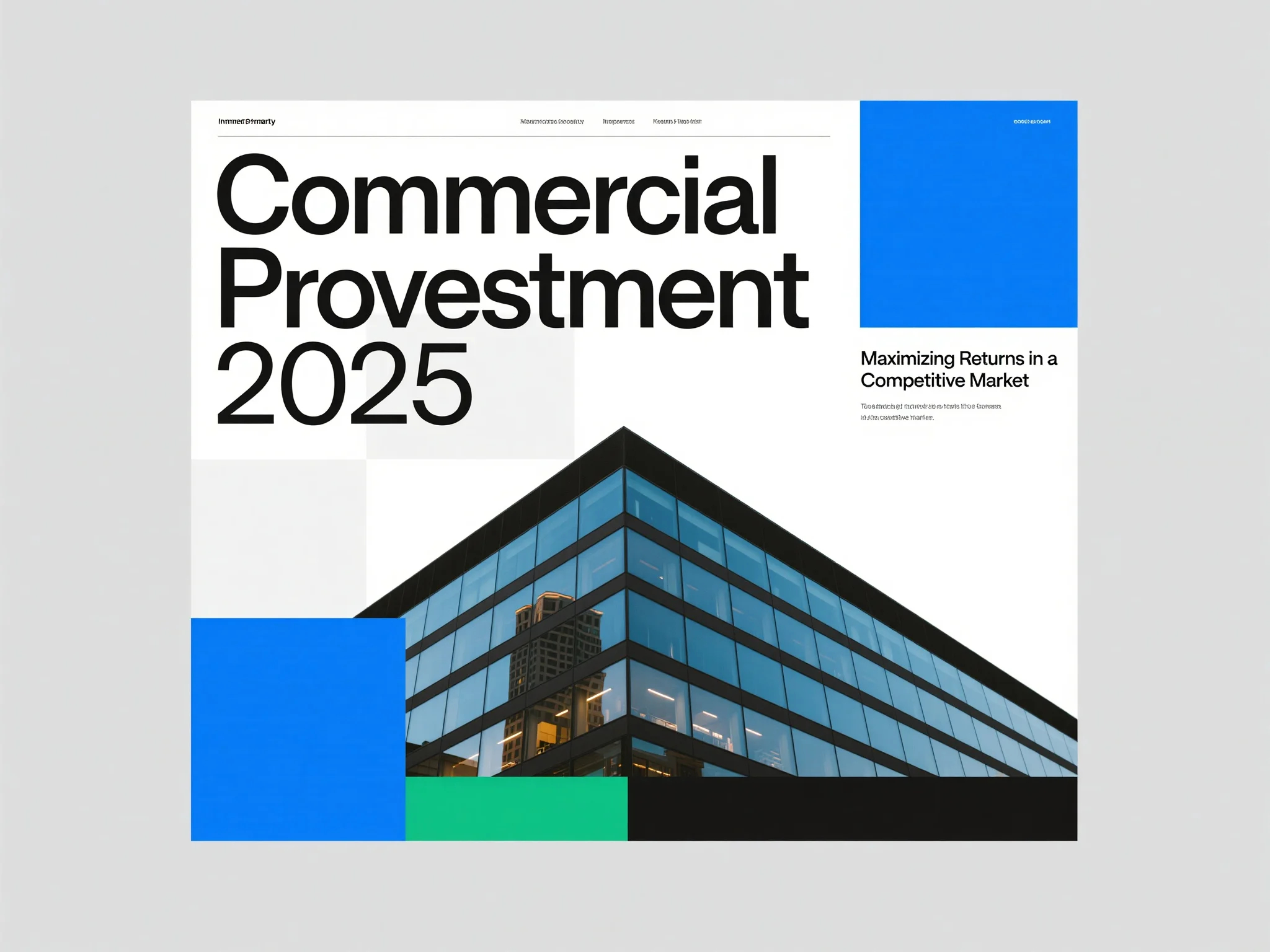The Strategic Landscape of Commercial Real Estate Investment The commercial real estate sector has emerged as one of the most dynamic and potentially rewarding investment categories for sophisticated investors seeking to diversify their portfolios and generate substantial returns in an increasingly competitive market environment. Commercial property investment 2025 presents unique opportunities driven by evolving workplace dynamics, technological advancement, and demographic shifts that are reshaping how businesses utilize
physical space and how investors approach commercial real estate as an asset class. The market has demonstrated remarkable resilience and adaptability, with investors recognizing the long-term value proposition of well-positioned commercial properties that offer stable cash flows, appreciation potential, and inflation hedging characteristics that are particularly valuable in uncertain economic environments. Successful commercial property investment requires comprehensive market analysis, careful due diligence, and strategic positioning that takes advantage of emerging trends such as mixed-use development, sustainable building practices, and technology integration that enhance property values and tenant satisfaction. The investment landscape has become increasingly sophisticated, with institutional investors, private equity firms, and high-net-worth individuals competing for premium commercial properties in markets that offer strong fundamentals, growth potential, and favorable regulatory environments. Market dynamics are influenced by factors such as interest rates, economic growth, employment trends, and consumer behavior patterns that directly impact commercial property demand, rental rates, and investment returns across different property types and geographic markets.Securitization and Investment Vehicle Innovation The evolution of commercial mortgage-backed securities has transformed the commercial real estate investment landscape by providing investors with liquid, diversified exposure to commercial property markets without the capital requirements and management responsibilities associated with direct property ownership. These sophisticated financial instruments have democratized access to commercial real estate investment opportunities while creating new avenues for capital formation and risk distribution across global financial markets. The CMBS market has matured significantly, offering investors
various tranches with different risk-return profiles that cater to diverse investment objectives and risk tolerance levels, from conservative income-focused strategies to more aggressive growth-oriented approaches. Market participants have developed increasingly sophisticated analytical tools and risk management frameworks that enable more precise pricing, due diligence, and portfolio construction strategies that optimize returns while managing downside risk exposure. The regulatory environment for commercial mortgage-backed securities has evolved to include enhanced disclosure requirements, risk retention rules, and capital adequacy standards that have improved market transparency and investor protection while maintaining the efficiency and liquidity that make CMBS attractive to institutional investors. Innovation in securitization structures has led to the development of specialized CMBS products that focus on specific property types, geographic regions, or investment strategies that allow investors to target particular market segments or themes that align with their investment objectives and market outlook. The integration of technology and data analytics has enhanced the underwriting process, risk assessment capabilities, and ongoing monitoring of CMBS investments, providing investors with better information and more sophisticated tools for making investment decisions and managing portfolio risk.Industrial Property Market Dynamics and Investment Opportunities
Industrial property investment USA has experienced unprecedented growth and investor interest driven by e-commerce expansion, supply chain optimization, and the increasing importance of logistics infrastructure in the modern economy. The industrial property sector has benefited from structural changes in consumer behavior, business operations, and global trade patterns that have increased demand for warehouse, distribution, and manufacturing facilities in strategic locations near population centers and transportation hubs. Investment opportunities in industrial properties range from traditional warehouse and distribution facilities to specialized properties such as data centers, cold storage facilities, and last-mile delivery centers that serve the evolving needs of modern businesses and consumers. The sector has attracted significant institutional investment due to its stable cash flows, long-term lease structures, and the essential nature of industrial facilities that provide businesses with critical operational infrastructure. Market fundamentals for industrial properties remain strong, with low vacancy rates, rising rental rates, and limited land availability in key markets creating favorable conditions for property appreciation and investment returns. The development of industrial properties requires careful consideration of location factors, transportation access, labor availability, and regulatory requirements that can significantly impact project feasibility and long-term investment performance. Successful industrial property investment strategies focus on properties that offer modern amenities, efficient layouts, and strategic locations that meet the evolving needs of tenants while providing investors with stable income and appreciation potential over time.
Tax-Advantaged Investment Strategies Through Opportunity Zones
The implementation of opportunity zone investments has created compelling tax-advantaged investment opportunities for investors seeking to deploy capital gains into commercial real estate projects located in designated economically distressed communities across the United States. This innovative program provides significant tax benefits including deferral of capital gains taxes, reduction of tax liability on deferred gains, and complete elimination of taxes on appreciation generated by opportunity zone investments held for at least ten years. The opportunity zone program has attracted substantial investor interest and capital deployment, with billions of dollars flowing into qualified opportunity zone funds that focus on commercial real estate development, renovation, and acquisition projects in eligible census tracts. Successful opportunity zone investment strategies require careful selection of projects, markets, and development partners that can execute complex real estate projects while navigating the regulatory requirements and compliance obligations associated with opportunity zone investments. The program has catalyzed significant economic development activity in previously underinvested communities, creating jobs, improving infrastructure, and enhancing property values while providing investors with attractive risk-adjusted returns and substantial tax benefits. Market participants have developed sophisticated investment structures and fund management strategies that optimize the tax benefits of opportunity zone investments while managing the operational and market risks associated with real estate development and investment in emerging markets. The long-term nature of opportunity zone investments requires careful consideration of market trends, demographic patterns, and economic development initiatives that could impact property values and investment returns over the required holding periods.

Collaborative Investment Models and Syndication Structures
Real estate syndication USA has emerged as a popular investment model that enables individual investors to participate in large-scale commercial real estate projects by pooling capital with other investors under professional management and oversight. Syndication structures provide access to institutional-quality commercial properties that would otherwise be beyond the reach of individual investors, while offering professional management, diversification benefits, and the potential for attractive risk-adjusted returns. The syndication model has evolved to include various structures such as limited partnerships, limited liability companies, and real estate investment trusts that provide different levels of investor control, tax treatment, and liquidity options depending on investor preferences and investment objectives. Successful real estate syndications require experienced sponsors with proven track records, comprehensive market knowledge, and the operational expertise necessary to identify, acquire, and manage commercial properties effectively. The due diligence process for syndicated investments involves careful evaluation of the sponsor’s experience, the property’s fundamentals, market conditions, and the investment structure’s alignment with investor objectives and risk tolerance. Technology platforms have streamlined the syndication process, making it easier for sponsors to raise capital and for investors to access investment opportunities, conduct due diligence, and monitor their investments through online portals and digital communication tools. The regulatory environment for real estate syndications includes securities laws, investor accreditation requirements, and disclosure obligations that protect investors while maintaining the flexibility and efficiency that make syndications attractive to both sponsors and investors.
Market Sector Analysis and Property Type Diversification
The commercial real estate market encompasses diverse property types including office buildings, retail centers, industrial facilities, multifamily housing, and specialized properties such as healthcare facilities, self-storage, and data centers that offer different risk-return profiles and investment characteristics. Office properties have faced significant challenges due to remote work trends and changing space utilization patterns, creating opportunities for value-add investments, repositioning strategies, and conversion projects that adapt existing properties to new uses and market demands. Retail properties have undergone substantial transformation driven by e-commerce growth and changing consumer preferences, with successful investments focusing on experiential retail, mixed-use developments, and properties that serve essential needs and provide convenient access to target demographics. The multifamily sector has remained attractive to investors due to strong rental demand, demographic trends favoring rental housing, and the essential nature of residential accommodation that provides stable cash flows and appreciation potential. Healthcare real estate has emerged as a defensive investment category with stable tenants, long-term leases, and demographic trends that support continued demand for medical facilities and senior housing properties. Self-storage facilities have attracted investor interest due to their recession-resistant characteristics, low operating costs, and the flexibility to adjust rental rates in response to market conditions. Data centers represent a growing investment category driven by digital transformation, cloud computing adoption, and the increasing importance of data infrastructure in the modern economy. Successful commercial property investment strategies often involve diversification across property types, markets, and investment structures that optimize risk-adjusted returns while providing exposure to different economic drivers and market cycles.
Technology Integration and PropTech Innovation
The integration of technology in commercial real estate has revolutionized property management, tenant services, and investment analysis through the adoption of PropTech solutions that enhance operational efficiency, reduce costs, and improve tenant satisfaction and retention. Smart building technologies including IoT sensors, automated systems, and data analytics platforms provide property owners with real-time insights into building performance, energy consumption, and space utilization that enable more effective management and cost optimization. The COVID-19 pandemic accelerated the adoption of health and safety technologies such as touchless access systems, air quality monitoring, and space management tools that have become standard features in modern commercial properties. Virtual and augmented reality technologies have transformed the leasing process, enabling remote property tours, space planning, and tenant engagement that reduce transaction costs and improve the efficiency of commercial real estate marketing and leasing activities. Artificial intelligence and machine learning applications are being used for predictive maintenance, energy optimization, and market analysis that help property owners and investors make more informed decisions and improve investment performance. Blockchain technology is being explored for applications such as property transactions, lease management, and investment tokenization that could streamline processes and reduce costs in commercial real estate transactions. The adoption of technology in commercial real estate requires careful consideration of implementation costs, tenant acceptance, and the potential for technology obsolescence that could impact property competitiveness and investment returns over time. Successful technology integration strategies focus on solutions that provide measurable benefits to both property owners and tenants while enhancing the long-term competitiveness and value of commercial properties.
Market Outlook and Investment Strategy Optimization
The outlook for commercial property investment 2025 reflects a complex interplay of economic factors, demographic trends, and technological developments that will shape investment opportunities and market dynamics across different property types and geographic regions. Interest rate environments, inflation trends, and economic growth patterns will significantly impact commercial property valuations, financing costs, and investment returns, requiring investors to develop flexible strategies that can adapt to changing market conditions. Demographic shifts including urbanization, generational preferences, and workforce mobility will influence demand patterns for different types of commercial properties and create opportunities for investors who can anticipate and respond to evolving market needs. The continued evolution of work patterns, retail consumption, and industrial logistics will create both challenges and opportunities for commercial property investors who must navigate changing tenant requirements and space utilization trends. Environmental, social, and governance considerations are becoming increasingly important in commercial real estate investment decisions, with investors focusing on sustainable building practices, energy efficiency, and social impact that enhance long-term property values and tenant appeal. Global economic uncertainty, geopolitical risks, and regulatory changes will require sophisticated risk management strategies and diversification approaches that protect investor capital while capturing growth opportunities in dynamic market environments. Successful commercial property investment strategies for 2025 will combine fundamental analysis, market timing, and innovative financing structures that optimize risk-adjusted returns while positioning portfolios for long-term growth and income generation in an increasingly competitive and sophisticated market environment.




